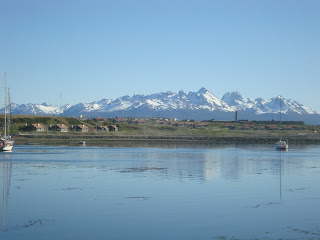So this morning, I donned my trekking gear (yes, I have some!), packed my shoulder bag with chocolate bars, water and my iPod and set off for the Glaciar Martial. You can see the route from the hostel window I realised when I got back, and I think if I'd looked at it before I'd set off I wouldn't have gone. Basically, the glacier is over the top of the mountain you can see in the background of this pic.

Most of you know my attitude to walking - I don't like it. Aimless strolls are not my thing. I can and have walked for hours around cities, where you can stop for a snack, coffee or beer periodically, and don't mind being on my feet all day. But humping for hours through wilderness with no purpose just doesn't do it for me.
However, I felt having come all this way I should at least give it a go. And at least this walk had a purpose, there was an aim, an endpoint - the glacier. Though when the guy on reception at the hostel said he'd never done the walk and thought it was really tough I began to get a bit nervous. Still, in for a penny etc.
I got a taxi over to the base of the mountain where the skiing chairlift was running, and caught that up to the first base. I could have walked up the piste, but that just seemed masochistic.

The chairlift quietly lifted me up past the treeline and deposited me at the top of the piste. A quick 10 minute stroll through some woods and I was thinking this is a piece of piss. What's all the fuss about.
However, emerging from the trees I was greeted by the real path to the top. It was at this point that I realised the glacier was over the top of the mountain, not at the top of the chairlift. Bugger.

I'd promised I wasn't going to give up at the first sign of pain, as is my usual wont, so set off, head down, counting the steps. The first half an hour up the gentle shale slope was OK, but it suddenly gets VERY steep about half way up the picture above, and as I looked up at the path ahead and saw tiny figures on seemingly insanely steep slopes thought I had no chance.
A quick two minute break, a swig of water, a chunk of chocolate and I set off again. I had to do this about half a dozen times before I crested the steepest point and it flattened out and the shale was replaced by rock and snow. Damn, I never thought I'd manage that. I was still nowhere near the glacier, but I'd got off the shale and was on the mountain proper.


So I sat feeling smug and then thought Sod it, carry on as far as you can. I climbed for maybe another fifteen minutes and realised that the only way I was going to get to the glacier was by climbing up the snow slope, the rocks were running out and I'd already gone into the snow up to my hip at one point. A guy went past me wearing crampons and I thought it probably a good idea to stop.

I hadn't made it all the way up, but I was feeling pretty pleased with myself and just sat their grinning to myself.

And enjoying the view back down off the mountain out over the city and the Beagle Channel. At the bottom I never thought I'd get this high and I'm sure lots of people go higher, but I'd got further than most - there were quite a few who were turning around below me.
It seems silly, but I was thoroughly pleased with myself. Pleased with myself for doing something I'm sure loads of people would find really easy. It only took an hour and a half to get to a paltry 2,500 feet, but I've never done anything like this before, so it was pretty special. In my head anyway! And the view back down was stunning, especially if you compare it with the pic I took out of the hostel window up the mountain.

Maybe climbing is the way forward rather than this trekking malarky. It was certainly very rewarding. And as I walked down off the mountain and down the piste, I kept turning round looking at where I'd got to. It was a strange compulsion I had to keep turning round and look at the mountain. I think I just didn't want to get off it.
Sorry if this post sounds like one long self-congratulatory message over what was actually a pretty tame achievement. But it felt big to me at the time, so up yer bum.











































